
|
|
Schoolgirl pilots take to the sky for holiday getaway by Olivia Hill-Douglas, The Age, 23 Nov., 2001
School leaver Anna O'Sullivan isn't allowed to drive a car or buy a beer at the pub, but flying a plane is no problem for the 17-year-old licensed pilot. Anna and her Lauriston schoolmate Eliza Russell, 18, who also holds a pilot's licence, are heading up to schoolies' week in Queensland along with thousands of other students - but they have eschewed the commercial airline route and are flying themselves and friend Rebecca Liley to Noosa in a single-engine plane. 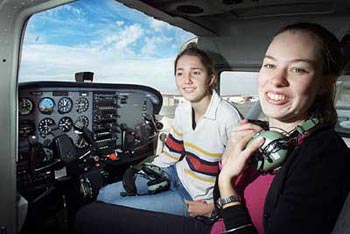 Schoolgirl pilots Eliza Russell and Anna O'Sullivan Photo : Wayne Taylor
"It's heaps of fun," said Anna. "The weather is absolutely gorgeous and there is no wind at all." Co-pilot Eliza agreed: "It went pretty smoothly. The weather is really good, so it's been not too hard."The girls co-piloted the plane in the air, but Eliza took control for take-off and landing, with Anna to have her turn on the next leg.
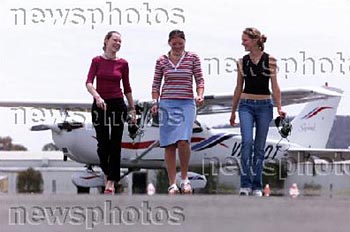 Anna O'Sullivan and Eliza Russell with passenger Rebecca Liley (c) Moorabbin Airport, Melbourne Photo : Chris McCormack, 22/11/2001
"The exams are finished, it's schoolies' week, she's about to get her driver's licence - it's all happening so fast," she said. "But I'm happy she's doing it this way and not driving up."Mrs Bader encouraged her daughter's interest in flying, and said she was amazed at how relaxed the girls were before their flight. "They were so Joe Cool about it all - they did their fuel tests, and spent hours on the flight plan - it's incredible," she said. Before the flight to Queensland, the furthest the girls had been without an instructor was Hamilton.
But in the April school holidays the six year 12 Lauriston aviation students flew to Adelaide, on to Coober Pedy and back to Melbourne via Broken Hill. Flying instructor and Lauriston teacher Julie Borschmann has been teaching the girls for three years. Students study theory in year 10, and begin their practical training in year 11. 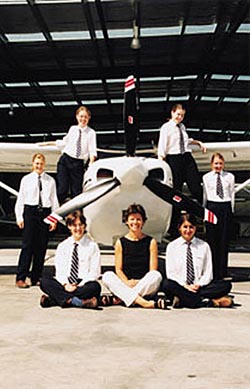 The first six pilots from Lauriston Girls School
Standing L-R : Michelle Barkley, Anna O'Sullivan, Charlotte McCubbin, Eliza Russell Photo : Lauriston
"It has increased the girls' confidence tremendously," she said. "It enhances decision making and helps with their organisation - you just have to be organised to fly a plane."Anna and Eliza have each clocked about 60 hours flying time and got their licences in June. They are "visual pilots" (not allowed to fly in cloud or at night). The girls spent last night in Coolah, north of Dubbo in New South Wales and are today flying to Toogoolawah, about 100 kilometres north of Brisbane, where they will again stop for the night. They plan to fly to Noosa early tomorrow morning. Neither Anna nor Eliza plan to become commercial pilots, but they don't discount it, either.
"I haven't planned to get a commercial licence," Anna said. "It would be fine to fall back on, but it's more training and more lessons." 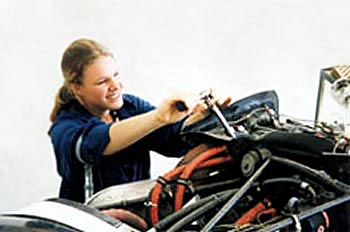 Michelle Barkley working on an aircraft engine Photo : Lauriston
School of the air lets dreams take off by Stathi Paxinos, The Age, 23 Aug., 2001
"I have felt the godlike power man derives from his machines ... the immortal viewpoint of higher air."As youngsters, when most of us gazed towards the clouds, we marvelled at the dog or human face that we could make out. But it was that small speck that may have crossed our line of sight that has sparked some to follow dreams of aviation. Yesterday four Lauriston Girls School students took another step towards cracking that intensely competitive career path. Anna O'Sullivan, Eliza Russell, Clare Davey and Michelle Barkley were presented with their private pilots' licences at a school assembly.
 The first six pilots from Lauriston Girls School L-R : Charlotte McCubbin, Lauren Ross, Clare Davey, Anna O'Sullivan, Eliza Russell and Michelle Barkley
The four students and classmates Lauren Ross and Charlotte McCubbin, who will be completing their practical exams at the end of semester, are the first students to do the two-year course, introduced in 1999. Lauriston believes that while other schools offer similar courses, its course, which costs $10,400, was the first in which students have earnt a full licence while still at school. Avid flyer Julie Borschmann, who teaches the aviation course, said it was introduced as a way to complement subjects such as physics and maths by sparking students' imagination. Ms Borschmann said the students learnt that it was not simply a matter of doing their best.
"You have to meet a standard, and that's quite different from a lot of schooling," she said.The students' reasons for taking the course are as varied as the careers they want to pursue. Charlotte and Clare have family members who were pilots.
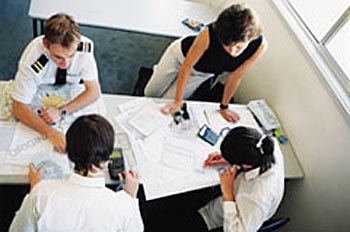 Theory and practice go hand in hand with the Lauriston trainees Photo : Lauriston
Lauren, who nominated pioneering aviator Amelia Earhart among her inspirations, wants to be a commercial pilot. It is an ambition she has held since she was about six. She has her sights set on a tertiary aviation course and wants eventually to fly for the commercial airlines.
"It was always one of those dreams you never thought you would be able to do, then the opportunity arose so it just seemed like the perfect thing to do," Lauren said.For Michelle, the course has opened doors to the world of aerospace engineering and eventually aircraft design. Australian aviation enthusiast Dick Smith, who spoke to the school after the presentations, said there was still an element of Charles Darwin's survival-of-the-fittest theory for women forging careers as pilots.
"It's still a lot harder for females but that means they've got to be better," he said. "The ones that do achieve an aviation career ... are the absolute best because most of the employers are male and I think there is still a certain amount of prejudice."
Lauriston Aviation by Julie Borschmann Lauriston Girls' School in Melbourne, Australia, launched its Aviation Programme in February 1999. One of the aims of the programme is to familiarise students with the world of aviation through ground theory and flight instruction. The school based ground theory is examinable as part of the curriculum in Years 10, 11 and 12. In 1999, the inaugural class of twenty-five Year 10 students studied, amongst other things, aerodynamics, propulsion, radar, air traffic control and meteorology. Additionally, the students participated in a variety of interesting excursions.
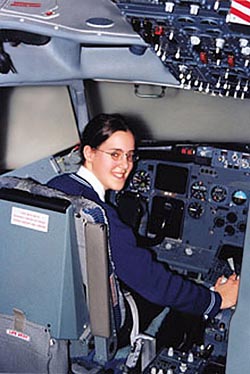 Clare Davey Photo : Lauriston
Qantas Boeing 767 First Officer Clare Irving and Captain Sandy Hawkins spoke to the class about their interesting careers as professional pilots with one of the world's great airlines. They provided the girls with valuable insights into the numerous opportunities available in aviation. In February 2000, six Year 11 students enrolled in formal flight training with General Flying Services at Moorabbin Airport, flying new Cessna 172R's. After ten lessons of dual instruction, they took to the skies on their own to complete a first `solo' circuit, watched by proud and exciting parents. Their achievements to date have been most rewarding with all girls demonstrating a keen commitment to their theoretical and practical training. They now face some twenty-five hours of training in advanced flight manoeuvres, after which they will be tested for the restricted General Flying Progress Test. The girls are all looking forward to taking their parents on a scenic flight sometime in December! As part of the Year 12 curriculum, all six students intend to complete their Private Pilot Licence by June 2001. Two students wish to pursue careers as professional pilots and hopefully this initiative of the School will assist them in achieving their goals. The programme, which will be fully developed by 2001, will involve some forty-five students in Years 10, 11 and 12 with a target of ten new Private Pilots per year.
Flying School
Imagine if your classroom stretched as far as the horizon, and lessons were held in the cockpit of a plane. Well, believe it or not, the girl flying this plane is in school, flying school; and at sixteen, Eliza Russell has already gone solo. "I was really excited, a bit scared, but it was an amazing feeling first taking off. It's just like you're free. I probably wasn't as scared as I thought I'd be because there's so much to concentrate on and you don't really think of what could happen. You're just concentrating on what to do."Eliza goes to Lauriston Girls' School in Melbourne, where aviation classes are offered from year ten. In year eleven students can start proper training, and by the time they leave school most will have their full pilot's licence.
"The school wanted to encourage girls to consider careers and interests in science and engineering, and aviation fits most appropriately into these areas."Learning to fly means you need to know your maths and physics, and it isn't just about the fun part of winging across the open skies. There are hours of theory in what's called 'ground school'. This is where you find out everything about how planes work. "They do understand a lot about how planes work. They know the engines, they know the systems and I don't think anyone has really lifted up the bonnet of a car to show them how a car works." "It's pretty funny that I was actually doing this before I learned to drive a car. Learning to fly a plane is a lot more structured so I find it is easier to perform a pretty good thirty degree turn. It's easy to control the plane because you've got all your dials, whereas I find right hand turns in an intersection are just so difficult and I do them so badly. I'm not an amazing pilot or anything, but I find it easier to fly than to drive a car."Lauriston's aviation students reckon that learning to fly is one of the most positive things they've done at school, and at least two girls plan to choose flying as a career. "I love it! I come back from every lesson and I'm just so excited. It's the most amazing thing you'll do because it's pretty unique."
7:30 Report Learning to fly : Transcript 8/8/2000 KERRY O'BRIEN: Modern teaching is a constant challenge. In the computer age, the knowledge age, an age of competing interests, teachers can never make assumptions that students will be delivered to their door as a captive audience. In a bid to encourage interest in science and engineering, Lauriston Girls School in Melbourne has introduced an aviation course, giving students the chance to gain their full pilot's licence while incorporating elements of physics and maths. 12 months later, the girls, who are still too young to drive unaccompanied, have taken to the air to fly solo for the first time. And as Kate Torney reports, it's also a golden career opportunity for the youngsters. KATE TORNEY: It's fair to say that school isn't what it used to be. The timetable for Year 10 and 11 students at Melbourne's Lauriston Girls School is just as likely to include a flying lesson as it is a music class. JULIE BORSCHMANN: The school wanted to encourage girls to consider careers and interests in science and engineering, and aviation fits most appropriately in these areas. KATE TORNEY: Julie Borschmann has been a primary teacher at Lauriston for 12 years. She gained her private pilot's licence in 1990 and then set about designing an aviation course for Year 10 and 11 students. JULIE BORSCHMANN: I think, from an early age, boys tinker with machines, they tinker with engines, and girls, for no particular reason, don't. I just think the seed isn't sown. The school also wanted to challenge the girls. They wanted the girls to be able to pursue a subject that they may not have considered before. KATE TORNEY: And so, 12 months ago, Lauriston became one of few Australian schools to offer aviation as part of the curriculum. The course is available from Year 10 and includes classroom-based theory as well as flight programs, and this term, six students aged just 16 flew solo for the first time. ANNA O'SULLIVAN: The first time you actually take the control column and do it, it's, like, the most amazing thing, you know, like thinking, "I'm controlling this whole aeroplane "and I'm up in the middle of the sky". But, yeah, it was really good to finally get there and all the theory that you've been learning suddenly means something. ELIZA RUSSELL: It was an amazing feeling, like, first taking off. It's just like, you're free. But I probably wasn't as scared as I thought I'd be because there's so much to concentrate on. You don't really think of what could happen, you're just concentrating on what to do. ANNA O'SULLIVAN: I think I was expecting it to be a lot more scary than it was. 'Cause you kind of, you can predict what your aeroplane's going to do by now, so you pretty much expect a bit of, when you bank or whatever, when you roll your aeroplane, you know what it's going to feel like. KATE TORNEY: At 16, Anna O'Sullivan is in the very early stages of learning to drive. ANNA O'SULLIVAN: It's pretty funny that I was actually doing it before I learnt to drive a car. Learning to fly a plane is a lot more structured, so I find it's easier to perform a pretty good, like, say, a 30-degree turn. It's easy to control it because you've got all your dials there, whereas I find right-hand turns in an intersection are just so difficult and I do them so badly. I'm not an amazing pilot or anything, but I find it easier to do well flying than it is to drive a car. ELIZA RUSSELL: With driving you just, I don't know, I just get in a car and often forget things because there are no checklists and I don't know anything about the engine or anything. I think flying's more -- because I know what I'm doing, I'm a bit more confident with it. JULIE BORSCHMANN: They do understand a lot about how planes work. They know the engines, they know the systems and I don't think anyone has really lifted up the bonnet of a car to show them how a car works. ROSS CARRINGTON, GENERAL FLYING SERVICES: The great difference between flying an aeroplane and driving a motor car is that everybody feels that it's their right to drive a motor car. But with flying, it's not everybody's right to fly an aeroplane. Skill and development and intensive training forms very much a part of that. KATE TORNEY: Do you think it takes a lot of courage on behalf of parents to actually watch their daughters up there in the air? MEG HANSEN, PRINCIPAL: Absolutely. I think for most parents it takes more courage for them than it probably does for their daughters. KATE TORNEY: What do you say to critics who might argue that at this level of education the girls should be concentrating on mainstream subjects? JULIE BORSCHMANN: I think those people haven't really looked at the big picture and the big picture is that this program a) complements their regular curriculum and b) is an outstanding opportunity to give the girls an enormous amount of confidence. KATE TORNEY: While tradition continues to dominate the school curriculum, Lauriston is now hoping that aviation will be formally recognised by the Victorian Education Department and in turn, contribute to the all-important tertiary entry score. ANNA O'SULLIVAN: I love it. Like, I come back from every lesson and I'm just so excited. It's the most amazing thing you'll ever do because it's pretty unique. Not many 16-year-old high school girls are able to say that "I can fly an aeroplane by myself.
and in more recent times...
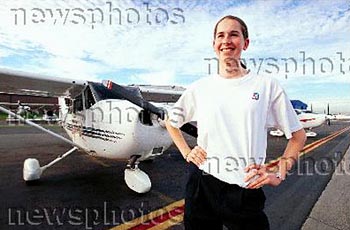 Lauriston pilot Alexandra McCubbin The Stonnington Leader, May 6, 2002 Photo : Chris Eastman
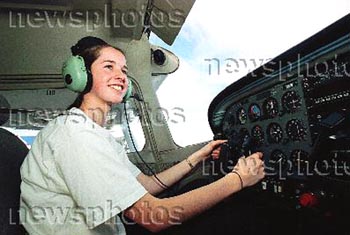 Lauriston pilot Alexandra McCubbin The Stonnington Leader, May 6, 2002 Photo : Chris Eastman
Links
Lauriston Girls School
Lauriston Girls School Aviation Program
|
© Copyright 1999-2002 CTIE - All Rights Reserved - Caution |